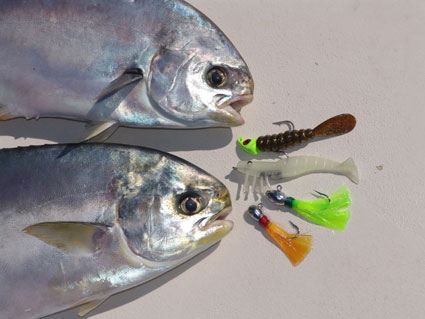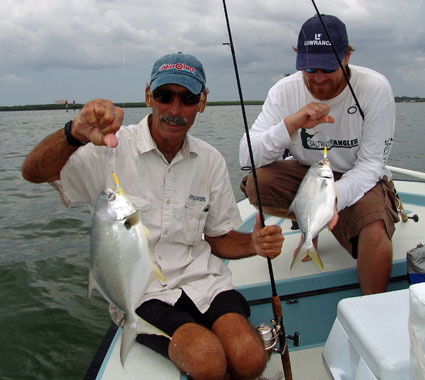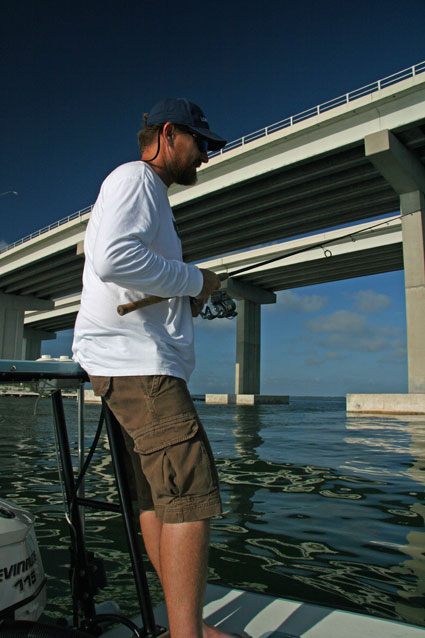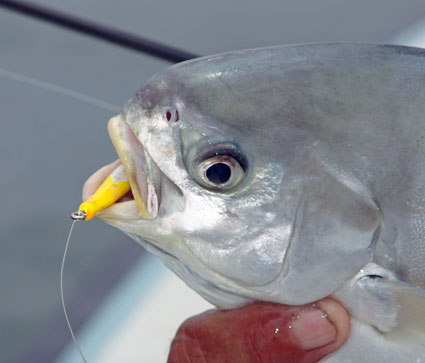November 19, 2012
By David Brown
Jigging nabs plenty of these tasty sportfish.

Small jigs and soft baits fool many fish and last a lot longer than natural bait amid the swarms of scavenger fish. |
Locating pompano often demands an active search and there's nothing better for that job than a jig. Low-maintenance, user-friendly and easily altered, jigs will quickly connect you with one of the sea's spunkiest fighters, who just happens to carry a pair of delicious fillets under his shimmering flanks. Here's a heads-up on pompano fishing with jigs.
A schooling fish, pompano require abundant food sources to satisfy the many mouths competing for meals. Along ocean beaches, they scour the wash for sandfleas and coquina clams. Inshore, pompano forage for small crabs, mollusks and shrimp. Oyster bars, rubble piles and limestone outcroppings see the occasional visit, but anglers consistently do best at bridges where currents funnel through the pilings.
One thing's for sure about these fish: Pompano simply will not sit still. The same can be said for many of today's inshore fishermen. Bottom fishing with sandfleas or bits of cut clam is a traditional tactic for pompano, but that requires patience and either blind faith or a healthy dose of confidence.
As Capt. Paul Hawkins of St. Petersburg notes, tide governs the casting game, with some spots delivering best on either the incoming or outgoing water. Determining a spot's ideal stage is mostly a trial-and-error deal, but take note of key factors such as depth, proximity to a main pass and how structures such as jetties, bridges or piers break or funnel the tide. The dynamics of food availability, current and oxygenation will guide you to the right time to fish each spot.
Pomps will feed directly under a bridge and right next to pilings, but that's not the only place to get them. The structure's influence on water flow creates plenty of feeding opportunities a good distance downcurrent.

Tampa Bay anglers land solid fish. |
During a south Pinellas County trip with Hawkins, we started our drifts about 20 yards from a mid-sized bridge and hooked up three times that distance downtide. The area was riddled with humps and flats, and as we drifted, a lot of strikes came along the edge of a sandy ridge. Slowing your progress with a drift sock or sea anchor is a good idea, as is watching the fishfinder for bottom contours suggesting feeding lanes.
“When you drift fast, you're more likely to run across a school of fish, but you'll blow through them very quickly,” Hawkins said. “On a slower drift, you may not find as many schools, but you'll have more time to work the fish.”
Controlled drifts are also wise in coastal passes where pompano forage along channel edges and jetties. The fish tend to find a depth they like and stick with it, so work deep-to-shallow until you find them. Light spinning tackle, 8- to 10-pound test mono or comparable braid, is best, affording long casts with lures weighing ¼ ounce or so. A fast-action rod is best, one whose flex under load begins mostly in the tip section and stiffens up toward the grip.

Current-swept channels and bars near coastal bridges are prime foraging areas for winter pompano. |
The warmer months see good pompano action in the shallow surf zone of beaches with light traffic, like the tranquil sands adjacent to the Bay and Gulf piers at Pinellas County's Fort DeSoto. Open flats, particularly those near coastal rivers and passes, also see a lot of pompano. The fish seem to favor broken bottom with uneven smatterings of sandy strips and troughs over dense grassbeds with distinct potholes. Unlike bridges and jetties, flats have nothing to hold pomps in one area, so it's more of an eat-and-run thing.
When traversing the flats, have a boat mate watch your wake for “skipping” pompano that bound across the surface when startled. Some fishermen call them “pie plates,” which makes complete sense when you see them. Stop and work the spot of last sightings, but if you don't connect, a looping run through the hot zone may revive the opportunity. Just be sure you don't blow out a flat for other boaters.
On the flats and in deeper water, large southern stingrays and tight pods of cownose (“bat”) rays often flush out the crustacean meals pompano seek, so keep an eye out for silver shadows in the wakes.
Regardless of where you find pompano, the jigging technique is largely the same. Get it to the bottom and twitch it like a scampering crustacean. Pompano eat plenty of shrimp and patiently working a small soft-plastic shrimp will draw attention. However, pomps spend most of their feeding effort nose down, bumping the bottom and watching/sniffing for crunchy meals. Crabs top the list, but when a caught fish regurgitates recent meals, you'll often notice shell fragments from snails, mussels and other mollusks.
A close look at the bottom will offer a clue to the local forage, while a little habitat sampling may aid your perception in deep spots. During my outing with Hawkins, we fished a bridge channel where I twice snagged chunks of the loose bottom and reeled the rock and shell mass to the boat. When I dropped the chunk on the deck, the impact shook loose several wriggling invertebrates. A closer inspection revealed no less than a half dozen tiny crabs hiding in the crevices.
For vertical jigging near bridge pilings, the standard lead head works fine, but for probing active areas with lengthy casts, it's hard to beat the banana-shaped jigs with weighted shanks made by Doc's Goofy Jigs and Silly Willy. Available in various sizes, these jigs carry their weight along the shank and that allows them to skim the bottom with the hook point facing up.
Increase your jig size as depth and/or current increases, but the key is presentation. Lower rod work keeps the jig close to the bottom where short hops stir up puffs of sand that resemble scooting crabs. Yellow or yellow/white patterns typically produce best, but the pink ones do well when visibility declines.

Goofy-looking jig you say? You're right, a Doc's Goofy Jig, to be precise. |
On the flats, the Nylure is a popular pompano jig, with its bullet head and nylon skirt trimmed close to the hook bend. Skirts can be yellow, red, chartreuse, or white, and some fishermen believe the chrome head throws just enough glimmer to catch a pomp's eye. At the same time, heavy leader may deter these sometimes shy fish; if you're after pompano primarily, you'll do best using no more than 20-pound-test monofilament or fluorocarbon leader.
Hungry pomps won't hesitate to grab small grubs, shad or curl tail jigs intended for trout and redfish. Smaller is usually better, so keep it to a ¼ ounce or less. In fact, freshwater anglers often fare well by putting their crappie jigs into pompano service. Those tiny 1/16-ounce jigs can be deadly, especially when rigged tandem with two different colors.
On the beaches, trim a grub tail to just above the jig's hook bend, throw parallel to the surf line just as a wave slides in and let the receding water roll your lure outward like a tumbling sandflea. Casting and retrieving slowly through the surf affords the same appearance, while allowing you to cover more water.
Sometimes it's a tap-tap-tug, but often the pompano strike feels like a PGA powerhouse just teed off on your bait. Big pompano will take drag, but all will give you a spirited fight with lots of tricky boatside antics. Fluttering leaps and defiant dashes don't end with the capture. For optimal freshness, Hawkins drops his keepers into a livewell until he heads to the dock. Preventing escapes, he said, is a constant concern.
“When you drop a fish into the well,” he said, “hold the lid low or your other fish will jump right out – I've seen them do it.”
No doubt they're quick, but pompano can also be downright bold. With Hawkins aligning our bridge channel drift, fellow Tampa angler Paul Arcos twice reeled his jig within a couple feet of the surface, only to watch a hostile pomp rise some 20 feet to boil beneath the lure.
As we discovered, a pompano that's fired up enough to chase a lure topside will put the chomp on the next available object that looks edible. My jig lagged about half the distance behind the one Arcos threw and my rod flexed within seconds of his second near miss.
Was it the same fish? We'll never know, but pompano and all schooling fish respond to the actions and influences of their brethren. In other words, if one makes an aggressive move toward a potential meal, you can bet he'll have a wad of competitive schoolmates following closely to capitalize on any peripheral opportunities. Convince a pomp that your jig is the right choice and your efforts will earn you one of the finest seafood dinners going.
FS
Originally Published Florida Sportsman Feb. 2010
Click Here to Have Florida Sportsman Magazine Delivered to Your Door.

